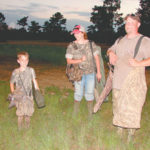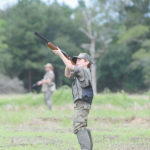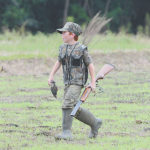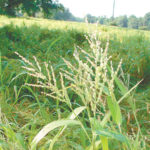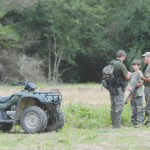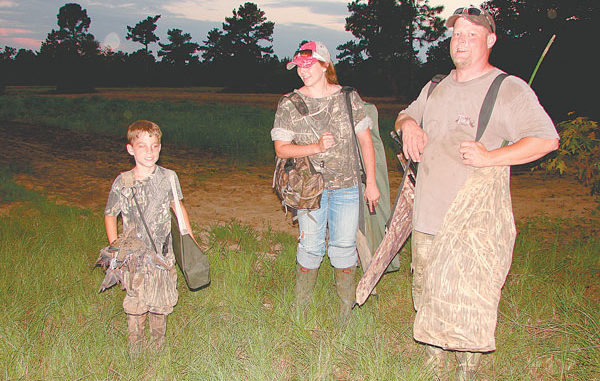
Word is, a Louisiana hunter can easily shoot his share of doves on this WMA, particularly if he has a young hunter in tow.
Dove hunting is one of our most popular small-game hunting activities, and opening day is almost upon us. According to surveys last year, Louisiana had approximately 36,000 dove hunters and harvested 665,000 doves.
Hunters will soon be dragging out their shotguns and looking for a place to take their kids hunting.
Jeff Duguay, the Louisiana Department of Wildlife and Fisheries’ dove expert, says the dry spring conditions made for favorable nesting, and there has been long-term population trend increases in dove numbers for the state. He is looking forward to a good season.
He notes doves can fly 55 to 60 mph. However, it is not the speed of a dove so much as its aerial acrobats that make dove hunting fun and challenging. It is always amazing how such a small bird can make a hunter look so foolish, so fast. That is half the fun.
There are a number of public wildlife management areas in the Florida Parishes, but the best for doves is the Sandy Hollow WMA.
Sandy Hollow encompasses 3,697 acres in Tangipahoa Parish approximately six miles east of the town of Amite. The habitat is rolling hills, and the timber is mostly longleaf pine. There are food plots and openings scattered across the area. The property is primarily managed for upland game birds. A copy of the area map can be downloaded off the LDWF website at www.wlf.state.la.us/wma/2764.
Sandy Hollow is composed of two separate tracts. The North Tract, north of Highway 10, and the South Tract, south of Highway 10.
The season on the North Tract of Sandy Hollow will open this year with a one-day Youth Dove Hunt on Sept. 3. The department has been concerned with decreasing hunter numbers during the last decade, and feels youth hunts are a great way to get kids involved in hunting. One of the nice things about the Sandy Hollow Youth Hunt is that the accompanying adult can hunt also.
Christian Winslow, the biologist supervisor in charge of Sandy Hollow, is looking forward to a good hunt if conditions are right.
“As many are aware, local dove populations can be erratic,” he said. “You can have a thousand birds on a field one day, have a cold front push through and be left with less than 20 birds the next day.”
Winslow reports there are three planted fields on the North Tract. The Atherton Field is approximately 18 acres and planted in browntop millet and wheat. The Verberne Field has approximately nine acres of millet. The Mike Field has close to five acres of millet. The fields are cut and burned just prior to the season.
The most productive field in recent years has been the Atherton Field. This year, participation on the Atherton Field will be restricted to the first 50 hunters to arrive. Last year, the Atherton Field was full and closed to additional hunters by 9 a.m. Shooting time on opening day starts at noon. As hunters leave for the day, other hunters will be allowed to take their places. Surplus hunters will be directed to the Verberne and Mike fields, where there are no hunter limits.
Adult hunters, with or without kids, can hunt the South Tract opening day. There is one 12-acre field of millet on the South Tract.
The Youth Hunt on the North Tract will be held only on the opening day of the first split (Sept. 3). The Youth Hunt is restricted to youths 17 or younger who must be supervised by an adult who is 18 years of age or older. The supervising adult must maintain visual and voice contact with the youth at all times. The daily bag limit is 15 mourning doves. There is no limit on Eurasian collared or ringed turtle doves, as long as a fully feathered wing and head is left on each. It is not legal to shoot Inca or ground doves. Shooting time starts at noon on opening day and closes at sunset.
All resident adults hunting on wildlife management areas must have a WMA hunting permit ($15) and a basic hunting license ($15). In addition, they must have a Harvest Information Program (HIP) certification (free). All individuals using the WMA, including kids and non-hunters, must stop at the check station designated on the map, and obtain a (free) self-clearing permit each day they visit the area. This is how the department determines how many folks are using the area, and what they are taking.
Hunters planning to spend the day should take plenty of fluids with them. It is usually very warm. Many hunters bring lawn chairs, and even camo umbrellas.
Hunters should also take plenty of ammo. Hunters should use small shot (9, 8, 7½). Larger shot can be extremely dangerous, especially on low flying birds in crowded fields.
This is a youth hunt, and firearm safety must be top priority. Ear protection and shooting glasses are highly recommended. Year before last, I made a tour of the fields to see how hunters were doing. I was surprised to note how many of the hunters were using some kind of hearing protection. When I was young, no one did. I suppose this generation is just smarter. It is a very good idea.
The department urges people to minimize disturbance to the fields on the days just prior to the hunt.
“We would like the birds to build in numbers undisturbed,” said Winslow. “If the birds are pushed off the fields before the season, there will not be much there on opening day.”
Historically, this hunt has been very successful and well received by the public. Randy Gros and his son, Rusty, made the hunt last year and report having a terrific time. Randy got his limit, but Rusty got only 14.
The other hunters, outside of some sky-busting at birds wearing oxygen masks, were all courteous and respectful. Randy described it as a quality hunt and a worthwhile experience to introduce young hunters to the sport. He urged prospective hunters to take plenty of water and be patient. There are lulls in the action, and you have to stay with it to be successful. He also suggests having a raincoat handy if bad weather is in the forecast.
On opening day of the 2010 hunt, area personnel checked 184 hunters and 709 doves (3.9 dove per hunter effort). Historically, the second and third splits have been very poor.
Last year, self-clearing permits indicated only three doves total were taken during second and third splits of the dove season.
During the 2009 opening hunt, it was estimated 207 hunters took between 450-500 doves.
Every year the department attempts to lease other dove fields for opening day. A fee is charged to hunt these fields. Hunters should check with the Hammond office (985-543-4777) to learn if there will be any pay fields in the area this year. The biologists will not know until the week before the season.
